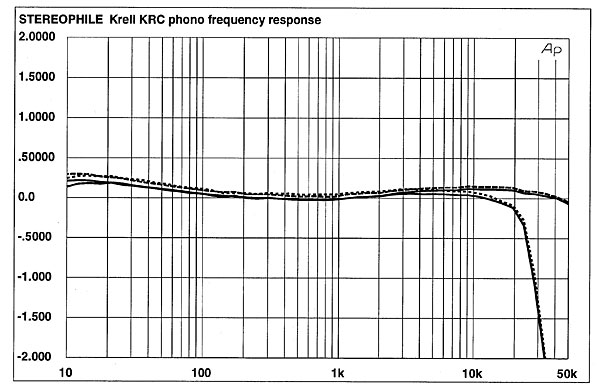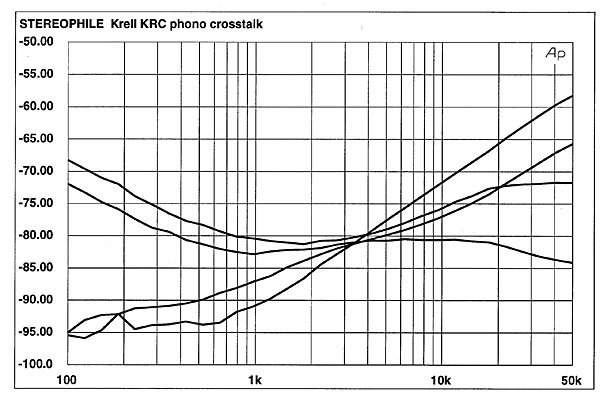| Columns Retired Columns & Blogs |
Krell KRC preamplifier Phono Module Measurements
Sidebar: Measurements
Footnote 1: All overload readings were made with an unequalized input signal; the differences with frequency are due to the inherent nature of the RIAA curve (a much lower-level signal is engraved at 20Hz in the equalized groove than at 20kHz).
The measurements presented here for the KRC Phono Module phono preamplifier were performed with a 47k ohm load in the MM configuration, and a 250 ohm load in the MC position (the latter chosen because it's 10 times the 25 ohm source impedance of our Audio Precision test set). In accordance with our normal practice, all phono-stage measurements were taken at the KRC's tape outputs. For logistical reasons, and because two KRCs with phono modules were available, the unit measured was not the one auditioned. However, the MC RIAA frequency response and overload margin were rechecked for the auditioned sample with no significant differences.
The measured gain with the loading specified above was 36.2dB, MM, and 62.8dB, left channel, 62.9dB right channel, MC. The MC gain did increase to 64.4dB with a 47k ohm load—virtually the same as the specified value of 64.5dB. The input impedance, as configured, measured just over 47k ohms, MM, and 288 ohms (L), 275 ohms (R), MC. The Phono Module is non-inverting, a positive-going input pulse emerging as positive-going at the tape output.

Fig.1 Krell KRC Phono Module, RIAA error MM (top) and MC (bottom) (right channel dashed, 0.5dB/vertical div.).

Fig.2 Krell KRC Phono Module, crosstalk (from top to bottom at 1kHz): R–L (MC); L–R (MC); R–L (MM); L–R (MM) (5dB/vertical div.).
The Phono Module's RIAA response is shown in fig.1. It's unnecessary for me to comment here, except note the rolloff above 20kHz in the MC mode. This won't be of any audible significance, and may help tame ultrasonic peaks common to most MC cartridges. The crosstalk in fig.2 is good, better in the MM mode below 3.5kHz, with the MC somewhat superior at higher frequencies.
The THD+noise of the Phono Module is also very low. Note that while we generally try for a 0.5mV input in measuring an MC input and 5mV for an MM, this level is rarely used, as noise generally dominates the readings at these levels. Thus, the reading doesn't indicate the actual distortion performance. We therefore find an input level at which the THD+noise at 1kHz drops to a minimum, rising with lower inputs due mainly to noise and rising again with higher inputs due primarily to THD. For the Phono Module, that point was 30mV for the MM configuration, 4.3mV for the MC. (These input levels were also used for the crosstalk measurements.)

Fig.3 Krell KRC Phono Module, THD+noise vs frequency (from top to bottom): MC at 4.3mV/1kHz; MC at 0.5mV/1kHz with 400Hz HP filter; MM at 30mV/1kHz (right channel dashed).
Since the latter is a high value—almost 19dB above the typical 0.5mV output (at 5cm/s) of an MC cartridge—there's the risk that this technique will show unrealistically high distortion at higher frequencies. Such a rise is visible in the topmost curve in fig.3. In order to determine if the high input was indeed responsible for this, I remeasured the MC THD+noise at 0.5mV, this time with a 400Hz high-pass filter in the circuit. The result indicates a much lower distortion above 10kHz, all the way to the test's 50kHz limit. Even at the higher input level, however, the rising distortion above 10kHz shouldn't be of audible significance; remember, the first harmonic distortion component of a 10kHz tone is at 20kHz. The THD+noise for the MM configuration was lower yet, and even at the high 30mV input used here, it doesn't really start to rise until about 35kHz.
The Phono Module's MM overload margin was excellent. The 1% THD+noise level was reached at 113mV input at 1kHz, 12.64mV input at 20Hz, and 650mV input at 20kHz (footnote 1), equivalent to margins of 27.1dB, 28.1dB, and 22.3dB, respectively. The MC results were less impressive: 5.27mV at 1kHz (visible signs of clipping were evident at 5mV), 0.59mV input at 20Hz, and 28.4mV input at 20kHz. The latter values are adequate, but the 20.5dB overload margin for the MC input at 1kHz is lower than that of many other high-end preamps we've measured. (For comparison, the American Hybrid Technologies measured 26.5dB, the MFA MC Reference 37.4dB, and the Rowland Consummate 27.4dB—though all of these phono preamps are notably more expensive.) Although I'd like to see a slightly better MC overload margin in the Phono Module, those measured here are unlikely to cause any difficulty with typical, low-output MC cartridges.—Thomas J. Norton
Footnote 1: All overload readings were made with an unequalized input signal; the differences with frequency are due to the inherent nature of the RIAA curve (a much lower-level signal is engraved at 20Hz in the equalized groove than at 20kHz).
- Log in or register to post comments




































